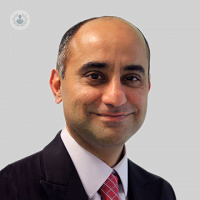Is a risk-reducing mastectomy right for you?
Written by:Some groups of women are at a much higher risk of developing breast cancer than others, so they choose to have both of their breasts surgically removed in the hope of avoiding the disease developing in the future.
However, deciding whether your risk is high enough to warrant the removal of both of your breasts can be a tough process to go through. Mr Haresh Devalia, one of our top breast and oncoplastic surgeons from the BreastClinic in South East England, is here to answer some questions we have on the topic to better inform you and hopefully help your decision-making.

What is a risk-reducing mastectomy and why is it done?
A risk-reducing mastectomy, also known as a prophylactic mastectomy, is a surgical procedure to remove one or both of the breasts and is done for certain women who are at a higher risk of developing breast cancer. As studies and evidence have consistently shown, a prophylactic mastectomy can significantly reduce the risk of developing breast cancer in the future and has a survival benefit.
Who is a candidate for a risk-reducing mastectomy?
Cancer is not often inherited, but in some types, such as breast and ovarian cancer, it can be influenced by the person's genes meaning they are at a higher chance than others of developing it. Therefore, risk-reducing mastectomies are offered to women:
- with BRCA1 and BRCA2 gene mutation
- who carry other gene mutations such as TP53 and PALB2 and have a strong family history of breast cancer (case-by-case basis)
- who are high risk as per the NICE guidance
In fact, every woman has these types of genes mentioned above but the problem is if a mutation develops in one of the genes, then, unfortunately, it gets inherited and increases the risk of breast cancer.
How effective is it at reducing the risk of breast cancer?
The practice of mastectomy can reduce the risk of breast cancer in women by 90-95% so it is deemed very effective.
What are the different surgical options?
A simple or total mastectomy is where the breast tissue and nipples are removed. However, most women will need to undergo a skin and nipple-sparing mastectomy, in which only the breast tissue is removed and the entire skin envelope with the nipple is preserved. Some women then decide to undergo breast reconstruction. These are the various types:
- Implant-based reconstruction - the surgeon will replace your breast using a saline or silicone gel implant.
- Flap reconstruction using the back muscle - an incision is made in your back and the muscle is slid under your arm to your chest and formed into the shape of a breast
- DIEP flap - soft tissue from the stomach replaces the breast tissue
You can find a detailed explanation of the reconstructive techniques on the BreastClinic website.
The ‘Angelina Jolie effect’
95% of women choose to undergo implant-based reconstruction as it is very straight forward and has a quick recovery and low morbidity.
It’s likely a popular procedure due to the diagnosis and treatment related to American actress, Angelina Jolie, who underwent a double mastectomy in 2013 and then an implant-based reconstruction nine weeks later. Subsequently, and after focused media attention on the practice of mastectomy, medical experts noticed a spike in genetic tests for breast cancer and a dramatic increase in women opting for the same treatment. Across the medical community, this is known as the Angelina Jolie effect.
Although Angelina Jolie underwent two separate operations, I often perform a mastectomy and reconstruction as a single procedure, meaning only one operation will be needed.
What other options are there to reduce your chances of breast cancer?
For those who are gene-positive and do not want to undergo a mastectomy, there is another option: Enhanced surveillance with a regular breast MRI scan and mammogram.
Regular screening may improve the chance of breast cancer being detected at an early stage so the cure rate is much higher.
The link between breast and ovarian cancer
Women who are at a high risk of developing breast cancer are also at a high risk of developing other cancers too. In women with BRCA 1 and BRCA 2 genes particularly, there is a link between breast and ovarian cancer. Therefore, in a similar way women may be offered a mastectomy, they can be offered a prophylactic removal of the ovaries and fallopian tubes too (salpingo-oophorectomy) to prevent ovarian cancer developing.
Additionally, BRCA women are at an increased risk of ovarian cancer. As the removal of these reproductive organs will mean the woman won’t be able to conceive, we often recommend, if the woman wants to have children, that she wait until afterward.
Breast cancer generally carries a very good prognosis and, like all cancers, the survival rate is consistently improving as we continue to understand more about the disease and improve the effectiveness of the treatments available. In the UK, the breast cancer survival rate has doubled over the last 40 years!
If you are worried about breast cancer and would like to talk to an expert for advice, visit Mr Haresh Devalia’s Top Doctors profile and schedule an e-Consultation with him.


